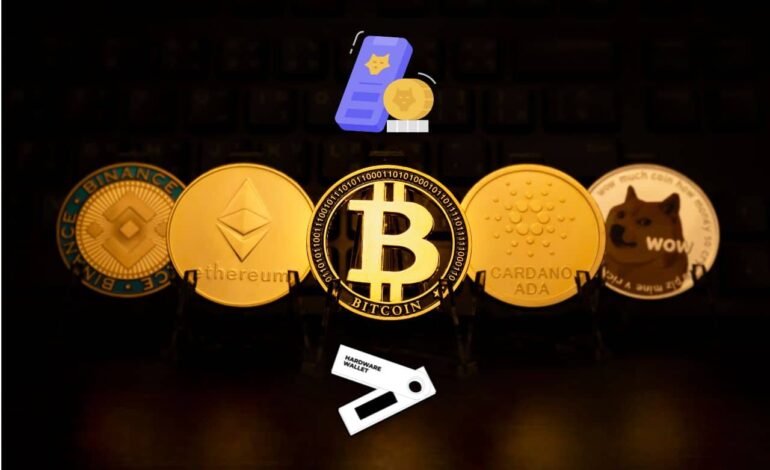In the previous article, we explored capital allocation and management in crypto investing. This article dives deeper into the cryptocurrency market, explaining foundational terms: What is Blockchain? What is Cryptocurrency? What’s the difference between a Coin and a Token? And what defines a foundational blockchain?
BLOCKCHAIN AND CRYPTOCURRENCY
What is Blockchain?
In simple terms, Blockchain is a chain of blocks linked together, allowing for secure and private data transfer across the globe. Information transferred is stored in these blocks and distributed across a network of computers, unlike traditional centralized storage (servers, cloud storage) on the internet. With Blockchain, data is decentralized, and transactions require verification from the network, making data alteration impossible.

Blockchain consists of interconnected data blocks
Key advantages of Blockchain:
- High security
- Immutable and unchangeable data
- Complete transparency
- Rapid data transmission
What is Cryptocurrency?
One significant application of Blockchain is Cryptocurrency, also known as Digital Currency, Cryptographic Currency, or Virtual Currency. Bitcoin (BTC) was the first Cryptocurrency on Blockchain. Similar to the U.S. dollar, BTC holds value because it’s recognized by a community as a means of exchanging goods and services.
While Bitcoin was the first Blockchain-based cryptocurrency, limitations in its technology led to the development of newer Blockchain platforms like Ethereum (ETH), Cardano (ADA), Binance (BNB), and Solana (SOL). This progression highlights the ongoing innovation in the crypto market as even more advanced Blockchain platforms emerge.

DISTINGUISHING COINS FROM TOKENS
Since Bitcoin (BTC), many other cryptocurrencies have been launched, each with a unique purpose, technology, and features. Many later coins are built on improved Blockchain platforms, such as Ethereum (ETH), Ripple (XRP), and Cardano (ADA).
We often refer to these as “coins,” but within cryptocurrencies, there are actually two categories: Coins and Tokens. So, what differentiates a coin from a token?
What is a Coin?
A Coin is a type of cryptocurrency that exists on its own Blockchain. For example:
- Bitcoin operates on its own Bitcoin Blockchain.
- Ethereum operates on the Ethereum Blockchain.
- Litecoin operates on the Litecoin Blockchain.
Therefore, coins are developed on their unique Blockchain platforms.
What is a Token?
A Token is also a type of cryptocurrency, but it is created and operates based on the open-source code of an existing Blockchain. For instance, many Tokens are created on the Ethereum platform (commonly known as the ERC network). In 2017, numerous tokens were launched on Ethereum (ETH), driving up ETH’s value over 100 times within just one year because Ethereum-based Tokens require ETH for transactions and operations.
In 2020-2021, another Blockchain platform—Binance Smart Chain (BSC)—became popular for token creation, which fueled a rapid increase in BNB’s value in early 2021. Other Blockchains also support token development, such as TRON (TRX), POLYGON, and POLKADOT.

Creating a Token is often simpler in terms of technical requirements, time, and cost compared to developing a Coin, while still benefiting from the security of the original Blockchain and meeting all necessary project requirements. However, this doesn’t mean that a coin inherently holds more potential or value than a token. Each project has its own value, regardless of whether it operates on its own Blockchain or on another platform.
What is a Platform Coin?
Understanding the difference between Coins and Tokens helps explain why many Coins/Tokens have multiple platforms to choose from for transactions. For example, when withdrawing or transferring USDT from an exchange, you may see four network options: BEP2, BEP20 (BSC), ERC20, and TRC20.
Coins are backed by their own Blockchain platforms. Some Blockchains, being open and highly versatile, are chosen by later projects to build Tokens, creating a robust ecosystem on that Blockchain platform. Examples include Ethereum and Binance Smart Chain.
Today, numerous Blockchain platforms host projects. The most widely used platforms are Ethereum (ERC), Binance (BEP), TRON (TRX), and Polygon, among others.

Some projects can operate across multiple platforms. For example, USDT (a tokenized USD) currently runs on three different platforms: Ethereum (ERC20), Binance (BEP2 and BEP20), and TRON (TRC20). Therefore, when sending or receiving any Coin/Token, make sure you select the correct network for accurate transfers.
Other notable platforms include Polkadot, HECO, Avalanche, FANTOM, SOLANA, XDai Chain, and more. Understanding these foundational Blockchain networks is essential for transactions, wallet storage, and other frequent interactions mentioned throughout this guide.
The two most prominent Blockchain platforms with the highest number of Token projects are:
- The Ethereum platform with the ERC20 network
- The Binance Smart Chain (BSC) platform with the BEP20 network
- The TRON platform with the TRC20 network
In summary, this article has covered what Blockchain is, the differences between Coins and Tokens, and the concept of Platform Blockchains. In the next article, we will delve into Types of Wallets in Cryptocurrency.



